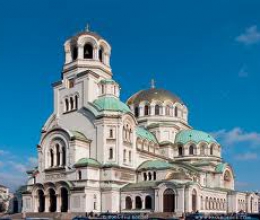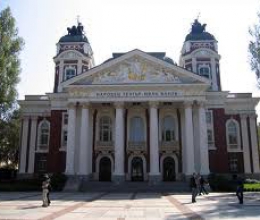Sofia |




 |
 |
 |
Sofia is Bulgaria’s capital and its largest city. Founded thousands of years ago, today the city continues to develop as the country’s cultural and economic center. At present, the city has a population of 1,250,000.
Sofia is located in the western part of the country, on The Sofia Plain and on the lower slopes of Mount Vitosha. The city’s average altitude is 550 meters above sea level, the climate is moderate and continental, characterized by cold winters and relatively cool summers. The average temperature in January is 1 degree below zero Centigrade, and the average July temperature is 20 degrees Centigrade.
The city is located at a strategic crossroads. The route from Western Europe to Istanbul passes through Sofia via Beograd and Skopje, then through Plovdiv to Turkey. Sofia also connects The Near East and The Middle East, lying between the banks of The Danube and the shores of The White Sea on the one hand, and between The Black Sea and The Adriatic on the other.
Three freeways begin in Sofia: Trakia, Lyulin, and Hemus. The Sofia Airport provides travelers with convenient connections to all major European cities, and from the central train station and bus station passengers can reach every destination in the country.
Sofia has been settled for many millennia. In honor of its hot springs, in the 8th century BCE the Thracian tribes settled here gave the city its first name – Serdika or Serdonpolis. Serdika was the favorite city of Constantine the Great (reign 306-337), who said “Serdika is my Rome.” The city gained its present name at the end of the 14th century, in honor of the city’s major symbol, The Saint Sofia Basilica.
On April 3, 1879 it was declared the capital of the newly-liberated Bulgarian nation.
Sofia preserves many valuable monuments to its long and storied past. Visitors exploring the city’s streets can see remnants of The Eastern Gate from the days when Sofia was Serdika and Sredets, dating from the 2nd-4th centuries CE. These remains are exhibited in the underpass connecting the Presidential Palace and The Ministerial Council, surrounded by shops selling traditional Bulgarian souvenirs and rosewater.
The Saint Sofia Basilica, founded during the reign of Justinian (reign 527-565), is one of the oldest churches in the capital. Very close to Saint Sofia is The Memorial Church Saint Alexander Nevsky, now one of the city’s most recognizable symbols.The oldest church in Sofia is the Saint George Rotunda.
Petka Samardzhiyska Church, built in the 11th century. Another Christian monument in the region is the Saint Joseph Catholic Cathedral. While walking in the area, visitors will also see the Banya Bashi Mosque, built in the 16th century. Not far from the mosque is a synagogue, which houses a museum. There is hardly another city in all of Europe that has so many noteworthy Christian, Islamic, and Jewish monuments so close together. In the immediate vicinity, other historical remains are preserved, such as the municipal baths, the marketplace, and The Holy Sunday Church. Adjacent to this church is the Theological Seminary, which houses The National Historical and Archeological Museum. Other points of interest in the city include The Lion Bridge, The Eagle Bridge, The Russian Monument, and the monument to Vasil Levski (a Bulgarian revolutionary hero who gave has life in the struggle to free Bulgaria from the Ottomans in the 19th century).
In the midst of the city’s religious landmarks, directly across from The Presidential Palace, is The National Archeological Museum, which has in its collection some of the most valuable treasures discovered in Bulgaria.
There are many more capitals in the city, such as The Polytechnical Museum, The Museum of Anthropology, and The Sports Museum. Since it is the nation’s capital, Sofia constantly plays host to important cultural and musical events, conferences, and sports competitions. The National Palace of Culture, the city’s football stadiums, and the city’s large halls are venues for concerts and performances by famous individuals and groups.
During the months of May and June, The Palace of Culture will welcome performers participating in the festival “Sofia Music Weeks.” The capital’s many theaters and galleries offer a wide range of interesting exhibits and shows.
The city is a preferred destination for international congresses, and there are a great many halls and centers offering possibilites for every need.
Sofia and the immediate vicinity also boast a great many spa complexes. The hot springs at Bankya, a nearby resort offer wonderful facilities for rest, recreation, and wellness. There are ten spa centers within the capital’s city limits offering peace and relaxation, along with therapeutic and beauty treatments.
Like every big city, Sofia has something for every taste. There are a great many luxury hotels, including those that are part of international hotel chains. There is also a wide variety of hostels and smaller family guesthouses. There are a multitude of discotheques, restaurants, bars, piano bars, clubs, taverns, soda fountains, fast food outlets and many other kinds of entertainment.











